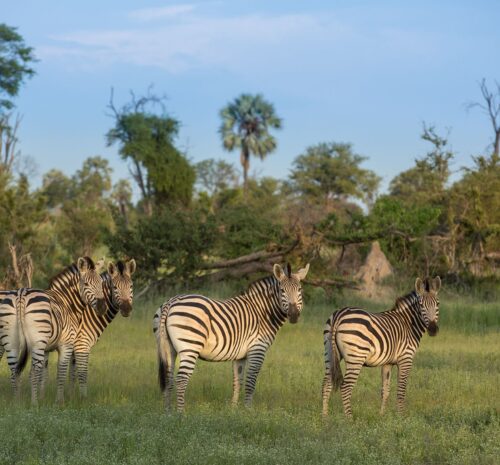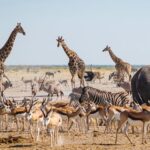The Zebra Migration in Botswana is a breathtaking natural event. Thousands of zebras journey across the landscapes, moving in a pattern as old as time, creating one of Africa’s most remarkable wildlife spectacles. Unlike other famous migrations like the wildebeest in Kenya and Tanzania, the zebra migration in Botswana is a hidden gem. This journey unfolds every year, with zebras traveling between Botswana’s lush Okavango Delta and the nutrient-rich Nxai Pan National Park. It’s a cycle of life, resilience, and beauty, showcasing Botswana’s commitment to protecting its wildlife and unique ecosystems.
In this blog, we’ll explore what makes the zebra migration in Botswana so special, why it occurs, and how you can witness this incredible journey. From the best times to visit to the unique behaviors of these remarkable animals, we’ll uncover the secrets of one of Africa’s most spectacular wildlife events.
Why Zebras Migrate in Botswana
The zebra migration in Botswana is all about survival. Zebras in Botswana migrate for food, water, and safety. During Botswana’s dry season, from June to October, the lush grasses in the Okavango Delta start to dwindle. With water and food resources running low, zebras are drawn to greener pastures. This instinctive journey leads them to Nxai Pan National Park and the nearby Makgadikgadi Salt Pans, where rains create fresh grazing lands.
The journey is not easy. Zebras walk hundreds of miles, crossing challenging terrains and facing predators along the way. Despite the hardships, the journey to the Nxai Pan National Park provides the zebras with enough sustenance to thrive and reproduce. For visitors, watching this natural drama unfold is truly awe-inspiring.
Best Time to Witness the Zebra Migration in Botswana
Timing is everything when it comes to seeing the zebra migration in Botswana. Each season offers a unique perspective on the migration:
-
December to March: Nxai Pan’s Prime Time
- This is the best time to see zebras in Nxai Pan National Park. The rainy season has turned the usually dry pans into green grasslands, attracting thousands of zebras.
- During this period, zebra herds can be seen grazing and nurturing their young. For wildlife photographers, this is an ideal time, as the lush green background adds contrast to the zebras’ black-and-white stripes.
-
April to May: The Journey Back to Okavango
- As the rains dwindle, zebras begin their migration back to the Okavango Delta. This is the period when zebras start to move in large groups.
- Witnessing their journey across the vast landscapes of Botswana gives visitors a deeper appreciation of the challenges these animals face.
-
June to November: Settling in the Okavango Delta
- By June, the zebras are back in the Okavango Delta. While they remain here until the next rainy season, this period offers a chance to see them in a different environment. The delta is teeming with life as it fills up with water, attracting many species.
How to Experience the Zebra Migration in Botswana
Experiencing the zebra migration in Botswana offers unforgettable moments. Here are some ways to make the most of it:
1. Book a Safari with Local Guides
Choosing Safari Packages with experienced local guides makes a big difference. Local guides understand the zebra migration patterns and know the best spots to observe zebras closely. They provide insights into zebra behavior, the environment, and the ecosystem that sustains them.
2. Visit Nxai Pan National Park
Nxai Pan National Park is a prime location for witnessing the migration. The open grasslands provide clear views, allowing visitors to see large herds. During peak migration, the park is filled with zebras and other herbivores, such as springboks and wildebeests, creating an impressive gathering of wildlife.
3. Stay in Mobile Camps
Several safari companies in Botswana offer mobile camps that follow the zebra migration route. This option lets you stay close to the herds, experiencing the migration’s dynamic movements each day. Mobile camps are eco-friendly, blending in with nature and offering an immersive experience.
4. Opt for Photographic Safaris
Photographic safaris cater to both amateur and professional photographers. Guides will take you to the best vantage points to capture the magic of the zebra migration in Botswana. The contrast of zebras against green or golden landscapes is a photographer’s dream, and some companies even provide tips on wildlife photography.
The Unique Patterns of the Zebra Migration in Botswana
Every migration is unique. While many animals migrate in groups, zebras have a particular style:
- Family Units: Zebras migrate in family units, with young foals staying close to their mothers. This protective grouping ensures that young zebras stay safe from predators.
- Communication: Zebras communicate using a variety of sounds, body language, and even facial expressions. During migration, this communication is crucial, helping them stay connected and avoid dangers.
- Diet and Grazing Patterns: Zebras are selective grazers, often eating the upper layers of grass. This diet is not only vital for their survival but also benefits the ecosystem. As zebras graze, they leave shorter grass, which then attracts other herbivores.
These unique traits make zebras special. Witnessing their behaviors during migration offers valuable insights into the adaptability of wildlife.
Conservation Efforts to Protect the Zebra Migration in Botswana
The zebra migration in Botswana is under protection due to conservation efforts by the government and conservation groups. Botswana has made significant efforts to conserve its wildlife corridors, recognizing that migration is essential for species survival. Through wildlife reserves, national parks, and laws, Botswana ensures that zebras and other migrating animals can move freely without the risks posed by human activities like farming and development.
Community Involvement in Conservation
Local communities are integral to conservation efforts. Many initiatives engage communities in ecotourism and sustainable practices, benefiting both wildlife and people. These programs create jobs, promote education on conservation, and reduce the human-wildlife conflict. Through these collaborations, the zebra migration in Botswanacontinues to flourish, and communities gain a sense of pride and responsibility in protecting their natural heritage.
Fascinating Facts About the Zebra Migration in Botswana
- Longest Known Zebra Migration: The zebra migration in Botswana is recognized as one of the longest zebra migrations in the world, spanning up to 500 kilometers.
- Seasonal Changes in Coat Color: Zebras adapt their coat color to the seasons. During the rainy season, their coats appear brighter, helping them blend with the lush environment.
- Role in the Ecosystem: As zebras move, they help spread seeds through their droppings, contributing to the spread of vegetation. This role is vital for the health of Botswana’s ecosystems.
- Natural Deterrent Against Predators: The zebras’ black and white stripes serve as a natural deterrent, confusing predators when the herd is moving together.
- Strong Social Bonds: Zebra herds are made up of family units that stay together for life. This strong social structure helps them stay resilient against challenges.
Practical Tips for Witnessing the Zebra Migration in Botswana
Seeing the zebra migration in Botswana requires some planning. Here are practical tips for your journey:
- Book in Advance: The best safari lodges and camps fill up quickly, especially during peak migration months. Booking ahead ensures you’ll have accommodations close to migration hotspots.
- Bring Proper Gear: Binoculars, comfortable clothing, and sunscreen are essentials. Botswana’s climate can be harsh, so prepare for both sun and rain.
- Respect Wildlife: While the urge to get close may be strong, it’s crucial to keep a respectful distance. Using binoculars or camera zoom features allows you to see clearly without disturbing the animals.
- Support Eco-friendly Operators: Choose safari companies and guides that prioritize eco-friendly practices. Sustainable tourism helps ensure that future generations can also experience the zebra migration in Botswana.
Why the Zebra Migration in Botswana Is an Experience of a Lifetime
The zebra migration in Botswana offers a unique perspective on the natural world. Watching these remarkable animals travel across Botswana’s vast landscapes is a reminder of nature’s resilience and beauty. The migration is not only a journey of survival for zebras but also a testament to Botswana’s conservation efforts and commitment to preserving its natural wonders.
Every aspect of this experience – from the thundering hooves of zebras to the expansive vistas of Botswana – makes it unforgettable. For those who love wildlife, the zebra migration in Botswana is a bucket-list event. It combines adventure, education, and a deeper understanding of our planet’s natural rhythms.
In Botswana, witnessing the zebra migration is more than just a trip; it’s a journey into the heart of one of Africa’s most magnificent wildlife spectacles.



